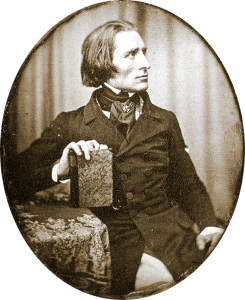 Our attention was recently drawn to a passage in our edition of Franz Liszt’s Études d’exécution transcendante (HN 717), which has not yet been annotated in any known critical edition. Ben Yin, a piano student of Prof. Claudius Tanski’s at the Mozarteum University in Salzburg, noticed while studying the notorious “Mazeppa” Etude (No. 4 of the Études d’exécution transcendante), that the outer voices at the first appearance of the theme (mm. 7 ff.) – unlike the middle voice played alternately by both hands – only incompletely fill in the 4/4-time measures:
Our attention was recently drawn to a passage in our edition of Franz Liszt’s Études d’exécution transcendante (HN 717), which has not yet been annotated in any known critical edition. Ben Yin, a piano student of Prof. Claudius Tanski’s at the Mozarteum University in Salzburg, noticed while studying the notorious “Mazeppa” Etude (No. 4 of the Études d’exécution transcendante), that the outer voices at the first appearance of the theme (mm. 7 ff.) – unlike the middle voice played alternately by both hands – only incompletely fill in the 4/4-time measures:
Now, in Liszt’s autographs and the editions based on them, this phenomenon occurs not only in cadenzas and “recitativo” passages, where freely augmenting the measure are a matter of course, but often also in “normal” passages, though whether this is a matter of negligence or error in their transmission can usually easily be clarified by comparing these spots with parallel or analogous spots. Here, however, a mere oversight is excluded since the incomplete filling out of beats 2 and 4 extends over many measures without any comparative parallel passage. Liszt’s notation is therefore intentional. Our edition follows the main source, the first edition (1852) of the Études d’exécution transcendante; comparison with the autograph engraver’s model shows no differences in this respect:
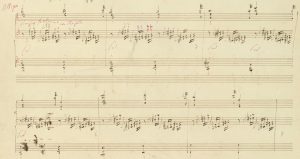
Autograph (engraver’s model) for Etude No. 4, measures 7–12 (Klassik Stiftung Weimar, Goethe- und Schiller-Archiv, siglum 60/I 23)
No doubt about it: the rendering of this passage is Urtext in both the first edition and Henle editions. But the original notation leaves open the question of how to deal with it. Do the gaps in the outer parts mean that they should be filled in with rests? Or should the duration of sustaining the chords (with the help of the pedal) be explicitly left up to the performer?
Glancing at the genesis of the etude will perhaps be of help. As is well known, the 12 Études d’éxécution transcendante constitute the final version of compositions dating back to Liszt’s youth. They were, in fact, first published in 1826 or 1827 under the title Étude pour le Pianoforte en quarante-huit Exercices (by Boisselot in Marseille and on commission by Dufaut et Dubois in Paris). In 1837, Liszt undertook a radical revision that was published in 1839 as 24 Grandes Études (by a total of four publishers, including Haslinger in Vienna). The numbers in the titles are misleading, incidentally, for all editions invariably contain only 12 pieces – all attempts at continuing the first series in order to arrive at 24 or even 48 individual works came to naught. In the case of No. 4, another version, composed as early as 1841 and inserted between the Grande Étude and Étude d’exécution trancendante versions, was published in 1847 (by Schlesinger in Paris and Haslinger in Vienna).
Let’s have a look at the relevant passage in the four versions.
The two-part Ur-etude is still far from the final version. Basic figures such as the thirds’ progression in the first section form the composition’s substance and are retained unchanged (resembling the basic figure in the second section). All measures are correctly filled out with rests.
In comparison with the first version, the etude is now considerably extended (169 instead of 77 measures) and has a theme that is subsequently changed melodically, harmonically and compositionally in five variations. The opening, now in 6/4 time, shows the idea of thirds retained as a voice in both hands, but receding before the new, full-fingered theme in the treble. The middle and bass voices complement each other to form triplet lines covering the entire measure, whilst the tempo changes from Allegretto to Allegro. The theme’s shape is already very similar to the final version (cf. Fig. above) with its three clearly distinguishable tonal registers and a strikingly prominent main idea. The measure is correctly filled out in all three lines; noticeable is only that the eighth-note triplets are not marked as such.
Apart from changes in the transition between variations 3 to 4 and at the end, the third version’s most striking innovations are, on the one hand, the five-measure introduction with diminished-seventh chords and, on the other, the title Mazeppa with the dedication to Victor Hugo. Liszt is thus alluding to Hugo’s eponymous poem of 1828, devoted to the tragic fate of the Cossack leader Ivan Masepa (1639-1709), who was glorified in literature around 1800. The piece’s trajectory can thus be described as from a characteristically figured etude via an expanded variation form to an extended pianistic poem (the reworking into a symphonic poem undertaken immediately after the publication of the final version seems only logical). The theme’s presentation is, however, unchanged from version II.
For the new revision at the beginning of 1851, Liszt took an exemplar of the 1839 Haslinger edition and entered the changes there. Where these were too far-reaching – as in the case of the theme from measure 7 onwards – he wrote the new version down on a leaf, so that the engraver’s model is comprised of folios from the old edition and new autograph sections. He expanded the introduction with a “cadenza ad libitum” of fast unison runs, thus further heightening the expectation of the “actual” beginning. The presentation of the theme itself appears sharpened in several respects: the thirds, now notated on their own stave, are shortened to 16th notes, and the respective upbeat notes to beats 1 and 3 in the theme are shortened to 32nd notes. The technical demands of the leaps in both hands appear to have once again been increased, still posing a great challenge today.
At first glance, the precursor versions II and III, managing without rests in the outer voices, suggest filling in the final versions’ treble without rests (i.e., a quarter note with triple dotting before the 32nd note), but then the bass quarter notes would have to be changed to half notes, which would mean a very substantial intervention in the surviving music text. Moreover, other passages in the piece with “lacking” dotting in the theme (such as mm. 31ff., 80ff., 114ff.), would then have to be changed, accordingly. In that sense, at second glance such interventions are proscribed. The question remaining, though, is what Liszt intended with such an “incomplete” notation. Are the quarter notes supposed to signify a minimum for sustaining the chords?
What do you think? We would be very happy if you would let us know your interpretation!

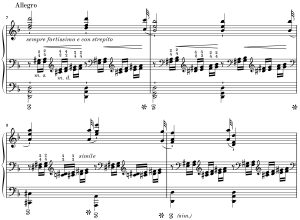
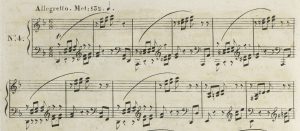

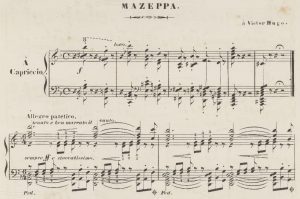
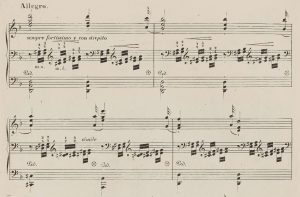
I myself think the rests and the constant clef changes make it unnecessarily difficult to read, though that may be the intent.Though it might violate certain principles of urtext, in my own scoring I would retain the separate pedal staff, but make the arpeggios cross staff between the top two staves, and dispense with rests as the intent is obvious.
While this passage is certainly unique, there is a long tradition of omitting rests to simplify the notation of keyboard music when there is no possibility of misunderstanding. And also a tradition of omitting rests to show that a hand is playing on the other staff, as in cross-handed playing. I think both of these traditions may have influenced Liszt’s notation. But that is not the end of the story.
The following thoughts occur to me despite not having seen the complete autograph or a proof copy. The article doesn’t mention the discrepancies in the pedaling indications between the autograph and the first edition. The pedaling appears to have been added hastily in the autograph. Note the absence of pedal terminations in most cases, and in the case of measure 4, one pedal appears where one would expect two as in m. 3. The first editor added the missing pedal terminations and solved the problem in m. 4 by eliminating the pedal termination. Henle supplements this with a sim., which was undoubtedly intended by the 1st edition.
However, all of this makes me doubt the authenticity of the pedal indications in the first edition, which may have some bearing on the notation under discussion. There was a tradition of omitting pedal terminations when a composer wanted a gradual pedal release; this is seen in Chopin’s piano music and elsewhere. It is possible that Liszt wanted the player to hold the half notes full length with the pedal to create a quasi-slurring to the following note despite the marcato touch, and then gradually release the pedal until it is completely up at the point where the rests are missing. The pedal would be applied and gradually released in the same way for the following isolated quarter notes. In this way, Liszt avoided notating what might appear to be an abrupt release of the quarter notes, again despite the marcato touch.
The absence of slurs between the 32nds and following quarter notes in the autograph may also be intentional and is worth noting in the Henle edition.
It seems to me the ‘hammered-out’ minim-crotchet-rest rhythm is very much the point in this passage. It should be felt, and therefore the implied rests should not be filled out. The pedal termination marks, that John Ruggiero casts doubt on, do therefore seem incorrect. I agree that Liszt probably wants a pedal release, or the start of a gradual release, well before the end of the bar, to give the intended rhythmic effect. Maybe adding rests just seemed unnecessary to Liszt, given that he has written staccato crotchets, and made them impossible to sustain with the fingers.
I think that the 32nd notes of the melody in octaves could be a way of writing a staccato, and consequently these 32nd notes are positioned in the same musical spirit as the previous editions, and these often omitted rests are not on the left but on the right. However, in terms of playing the instrument, the state of mind is to link the 32nd note and the following note, in a rapid leap, one could imagine a slightly slackened ‘almost together’, similar to the thirds played in groups of 3 in the 1847 edition, despite the 16th notation.
I also believe that those 32nd are played very similarly as the 16th when the theme comes back with C and 6/8 and 2/4 bars.
Liszt warned one of his students not to be too literal, so it is important to understand the state of mind, the aesthetics and the emotion before considering the arithmetical accuracy of the notation. There is another documentation about avoiding too much literacy in Liszt’s music. Liszt’s way to play “Funérailles” (Paëdagogium, Ramann) was to relax the 16th in the sotto voce pesante theme.
There is a similar question with the 8th (croches) of the theme played by the left hand at bar 62, il canto marcato e vibrato assai (poco animato il tempo, 1837 and 1847) and the melody on the left hand bar 159, sempre ff (con strepito, editions 1837, 1847), which are 32nd in editions of 1837 and 1847 and 16th in 1851: should the playing be indeed be different between the first and second occurrence? should they match the notes played by the right hand in the second occurence? or should there be a rigorous binary vs ternary rhythm arithmetic? Or should there be a similar mindset of “playing almost together”, and a Lisztian rubato involving detaching the left hand and the right hand?